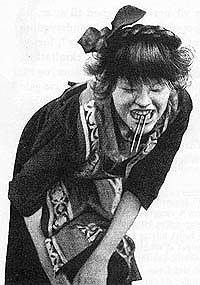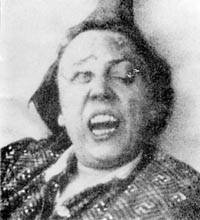
A schizophrenic woman, who is
excited and ready to bite.
Kraepelin's classification of mental illnesses.
Emil Kraepelin (1855-1926) created a classification of mental illnesses, which was used throughout the 1900s, and to a certain extent still forms the basis for diagnoses. He formulated a distinction between exogenous and endogenous psychoses.
The exogenous psychoses were categorized as a form of poisoning stemming from outside the patient. Examples of this were alcoholism, syphilis and morphine addiction. Kraepelin especially considered manic-depressive psychosis as endogenous, meaning something intrinsical though completely independent of the influence of one’s inner life.
Most important however, was his definition of the two major endogenous mental illnesses, schizophrenia (formerly called dementia praecox) and manic depressive psychosis. Kraepelin discovered that schizophrenia involved a dissolving of the personality, while the manic depressive personality remained intact.
In contrast to Kraepelin the diagnostic system of today, called ICD-10 doesn’t emphasize the causes of mental illnesses (poster no. 17).
August Wimmer
August Wimmer (1872-1937) was both a neurologist and a psychiatrist. In 1920 he was appointed Head of the Copenhagen Municipal Hospital and became Professor of Psychiatry at the University of Copenhagen.
Wimmer published his major work “Clinical Psychiatry – for Students and Physicians” in 1936. The book was written before psychoactive drugs were available (poster no.15) and provides a good insight into the symptoms of psychoses.
In 1916, August Wimmer described the psychogenic psychoses and showed that he disagreed with Emil Kraepelin’s theories and instead supported Sigmund Freud’s psychoanalysis.
Freuds theory was that psychogenic psychoses were mental disorders caused by traumatic experiences in the patient’s life.
Also in 1916 these theories were emphasised by observing the reactions that mentally healthy people had to the horrifying experiences in the trenches at the western front during World War 1. These reactions, called shell shock, are in reality momentarily bouts of mental illness provoked by the extreme conditions they had been exposed to.

A patient suffering from
catalepsy, sitting in a
hunched position. Symptoms
of this disease can include
extremes of behaviour. Patients
may be in a coma-like daze –
unable to speak, move or respond,
or they may speak and behave
in a bizarre hyperactive way.
This type of schizophrenia
often has an onset around
the age of 25 to 30.

A schizophrenic woman, who
is excited and ready to bite.
Schizophrenia
Schizophrenia is seen as an overall diagnosis with certain primary and secondary symptoms:
The primary symptoms are:
1. Disorders in contact with other people
2. Changes in thought patterns.
3. Changes in a person’s own will and action resulting in, amongst others, ambivalence
4. Changes in the emotional life, often manifesting themselves as intensified or weakened emotions.
The secondary symptoms:
1. Hallucinations
2. Delusions
3. Stress symptoms
4. Daydreaming
5. Lack of sense of reality about the outside world
6. Feelings of alienation towards oneself
7. Sense of weakened definition between one’s own person and other people
8. Catalepsy (disturbances in the pattern of movement)
Emotions connected to schizophrenia
A description of emotions connected to schizophrenia:
A gradual, almost imperceptible fading or withering of the emotional life, a state of emotional numbness. The afflicted patient gets more and more indifferent and apathetic towards his relatives ... he also loses interest in his emotions concerning his own situation (employment, plans for the future) looses the ability to show empathy towards his surroundings and gradually he slips into a state of isolation (autism).
Wimmer p 2
Description of Schizophrenia.
Schizophrenia as it is described in the textbook of August Wimmer: “Specific Clinical Psychiatry” from 1936.
Psycho-motor tensions:
“He has affected manners and he has to think about his movements when in need of doing something for example walking, eating, writing. He is stopped in his movements as by the will of someone else his actions are always to and fro ...
”Theft of thoughts:
“My thoughts are passing my inner self as illusions ... It's as if someone else is in control, takes over my thoughts and weaves them with thoughts of strangers, which leaves me incapable of recognising my own thoughts. But that might be amnesia. There must be different persons who speak through me ...”
Wimmer p 306
Schizophrenic hallucinations:
“The voices sound like two people in conversation, they ask her about her most intimate affairs, make fun of her ... comment or correct, mention a name ... an inquiry is made. The voices are taking over every thought she has …”
Wimmer page 301
Delusions in connection with schizophrenia:
“I am Christ Filip. Christ is my grandfather and Fillip is my father ... I am the law and the Danish mother of the world, my sons are Frederick VI, Frederick VIII and Christian X... I’ve never had my own head. It has been detained in Russia for a very long time ...”
Erik Strömgren: Psychiatry (page 172)
Delusions of grandeur:
“I have had stepparents, lived as a poor child not knowing my real parents, although the whole world belongs to me. My father is a Vanderbilt, son of the German Empress Augusta and Frederick Branch, the later Tsar Alexander 2nd “
Wimmer p 309



